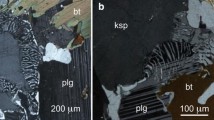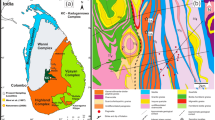Abstract
Gneissic rocks of the contact aureole of the Traversella Intrusion (N. Italy) reveal a cellular intergrowth of quartz and oligoclase (myrmekite), originating from alkali feldspar grain boundaries. The myrmekite occurs in a temperature range of 500 to 670°C. The size of the cells and the lamellar spacing of the quartz rods increase with rising temperature. A comparison of the characteristic features of myrmekite cells with discontinuous precipitation cells of alloys indicates many similarities between the reactions. A is concluded that the formation of myrmekite is a solid-state reaction; a supersaturated alkali feldspar decomposes into a cellular structure growing behind a moving incoherent grain boundary. Micro probe analyses of the original alkali feldspar, the reaction products, and the volume relationship of the reactants (quartz, sodium-rich plagioclase) show that an ion exchange occurs during the reaction (K+ removed; Na+, Ca2+ and Si4+ added). A model describing the early stages of the formation of myrmekite is presented.
Similar content being viewed by others
References
W. A. Deer, R. A. Howie andJ. Zussman, in “Rock-forming minerals”, Vol. 4, (Longman, London, 1963) p. 1.
L. Widenfalk,Lithos 2 (1969) 295.
H. Ramberg,Neues Jahrb. Miner. Abh. 98 (1962) 14.
E. R. Phillips,Lithos 7 (1974) 181.
F. K. Drescher-Kaden,Mineralogie und Petrographie in Einzeldarstellungen 1 (1948) 1.
G. Voll,Liverpool and Manchester Geol. J. 2 (1960) 503.
G. Voll,Fortschritte Mineralogie 60 Beiheft 1 (1982) 207.
W. Schreyer,Neues Jahrb. Miner. Abh. 92 (1958) 147.
R. Wirth andH. Gleiter,Acta Metall. 29 (1981) 1825.
M. Hillert, Met. Trans.3 (1972) 2729.
E. Hornbogen,ibid. 3 (1972) 2717.
C. Zener,Trans. AIME 167 (1946) 550.
R. Wirth,Neues Jahrb. Miner. Abh. 152 (1985) 101.
H. Schumann, “Metallographie” (VEB Deutscher Verlag für Grundstoffindustrie, Leipzig, 1975) p. 58.
C. S. Smith,Trans. Amer. Soc. Met. 45 (1953) 533.
D. A. Carmichael,Contrib. Mineral. Petrol. 20 (1969) 244.
H. Gleiter andB. Chalmers,Progr. Mater. Sci. 15 (1972) 139.
W. Q. Kennedy,Schweiz. mineralog. petrogr. Mitt. 11 (1931) 76.
R. Wirth,Neues Jahrb. Miner. Abh. 154 (1986) 193.
K. N. Tu andD. Turnbull,Acta Metall. 15 (1967) 369.
F. Spencer,Mineralog. Magazine 26-7 (1945) 79.
Author information
Authors and Affiliations
Rights and permissions
About this article
Cite this article
Wirth, R., Voll, G. Cellular intergrowth between quartz and sodium-rich plagioclase (myrmekite) — an analogue of discontinuous precipitation in metal alloys. J Mater Sci 22, 1913–1918 (1987). https://doi.org/10.1007/BF01132916
Received:
Accepted:
Issue Date:
DOI: https://doi.org/10.1007/BF01132916




